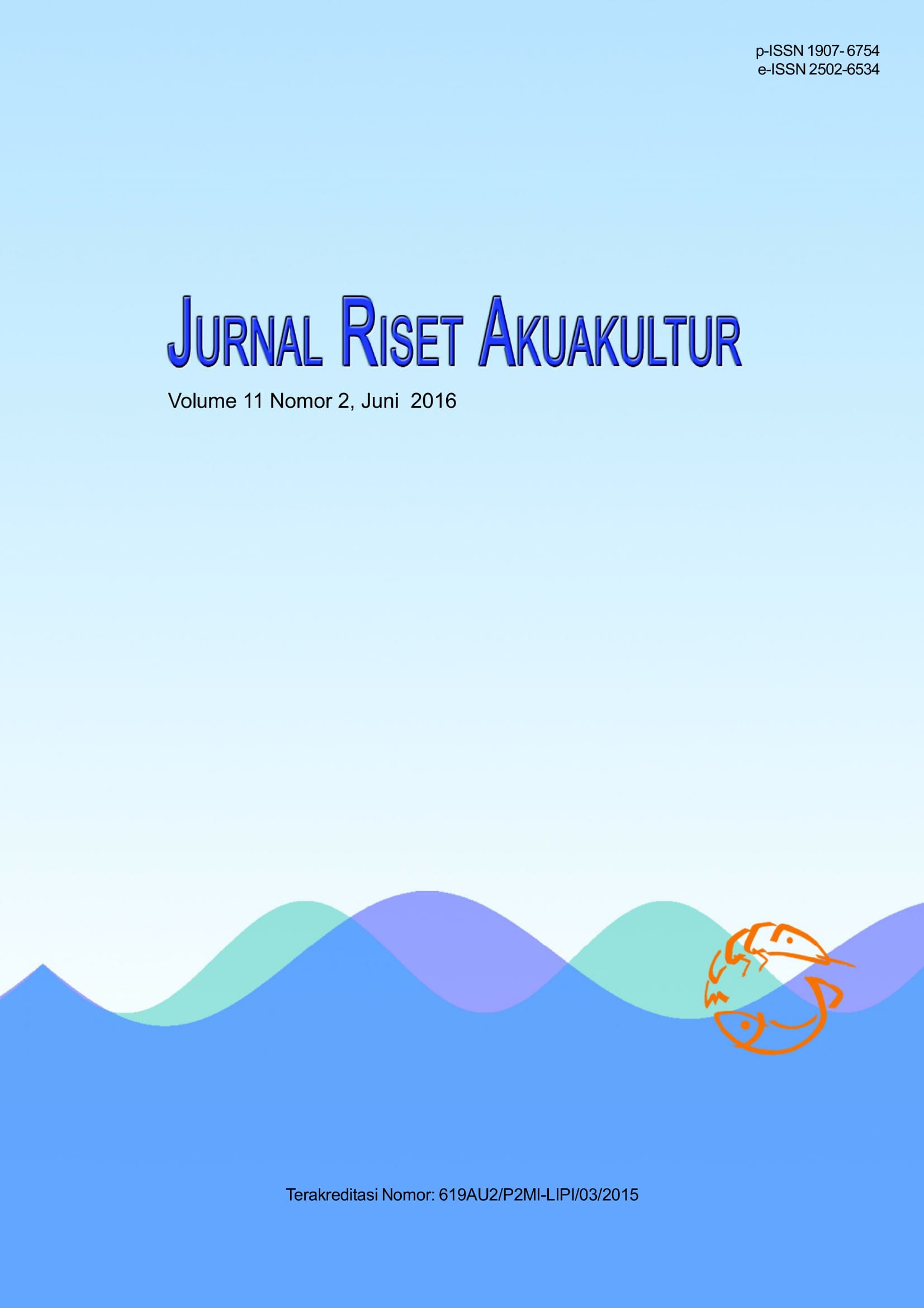PERFORMA BENIH TERIPANG PASIR, Holothuria scabra DARI SUMBER INDUK YANG BERBEDA
DOI:
https://doi.org/10.15578/jra.11.2.2016.147-154Keywords:
performa benih, variasi genetik, induk, mikrosatelit, teripang pasir, broodstock, genetic variation, juvenile, microsatellite, performance, sea cucumberAbstract
Upaya pengembangan perbenihan teripang pasir bagi kelestarian populasi di alam dan pengembangan budidaya patut dilakukan. Upaya ini diperlukan mengingat semakin intensifnya penangkapan teripang di alam yang dapat menimbulkan terganggunya kelestarian populasi ini. Tujuan dari penelitian ini adalah untuk mengevaluasi performa pertumbuhan benih teripang pasir, mendapatkan informasi keragaman genetik dan mengestimasi laju inbreeding dari 3 sumber induk teripang yang berbeda. Tiga sumber induk berasal dari perairan Bali, Sulawesi Selatan, dan Maluku Tenggara masing-masing sebanyak 20 ekor dianalisis menggunakan mikrosatelit (SSR/Simple Sequence Repeats) dengan 3 lokus, yaitu Hsc-28; Hsc-49 dan Hsc-59. Proses pembenihan mengikuti pedoman teknis yang sudah ada dengan beberapa modifikasi. Hasil yang diperoleh menunjukkan bahwa panjang dan bobot benih umur 6 bulan yang dihasilkan dari induk Maluku Tenggara relatif lebih tinggi (5,67 ± 0,76 cm; 13,26 ± 5,63 g) dibandingkan dengan benih dari induk Sulawesi Selatan (4,75 ± 0,91 cm; 6,3 ± 2,22 g) dan Bali (4,85 ± 0,64 cm; 6,2 ± 3,6 g). Hasil analisis mikrosatelit menunjukkan bahwa keragaman genetik induk teripang pasir dari ke tiga populasi tidak berbeda nyata. Hal ini berdasarkan nilai differensiasi genetik (FST= 0,2475 atau 24,75%). Laju nilai inbreeding dalam populasi induk teripang pasir cukup tinggi (FIT= 0,4237 atau 42,37%) dibandingkan dengan laju inbreeding antar populasi (FIS) adalah 0,2342 atau 23,42%.
The effort of sea cucumber seed production for culture development have to be carried out. This effort is also required due to the intensive exploration of sea cucumber in the nature which could threaten of its sustainability. The aims of this research is to evaluate sea cucumber juveniles growth performance, to obtain the information on genetic variation, and to estimate the rate of inbreeding from three different sea cucumber broodstock sources. Three sources of sea cucumber were collected from Bali, South Sulawesi, and Southeast Moluccas. The total of 20 pcs from each area were analyzed by microsatellite (SSR Simple Squence Repeat) with 3 locus namely Hsc-28; Hsc-49 dan Hsc-59. Hatchery production of sea cucumber seed followed the existing manual with some modifications. Result of the experiment showed that the length and weight of 6 months old juveniles produced by Southeast Moluccas’s broodstock were relatively higher (5.67 ± 0.76 cm; 13.26 ± 5.63 g) compared to the juveniles produced by South Sulawesi’s broodstock (4.75 ± 0.91 cm; 6.30 ± 2.22 g) and Bali’s broodstock ( 4.85 ± 0.64 cm; 6.2 ± 3.6 g). Results of microsatellite analysis showed that genetic variation of the three broodstock populations was not significant different. It is based on the genetic differentiation value (FST= 0.2475 or 24.75%. The result of inbreeding rate within the broodstock of sea cucumber population was high (FIT= 0.4237 or 42.37%) compare to the rate value of inter population (FIS= 0.2342 or 23.42%.
Downloads
Additional Files
Published
How to Cite
Issue
Section
License

Jurnal Riset Akuakultur is licensed under a Creative Commons Attribution-ShareAlike 4.0 International License.Â
